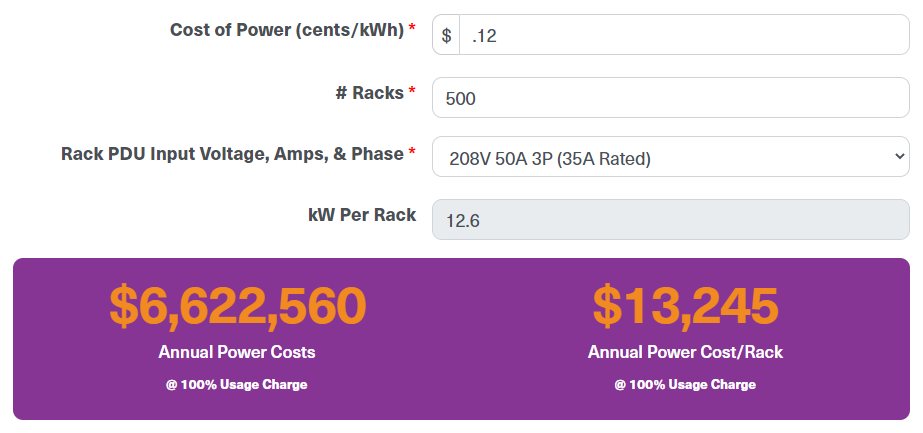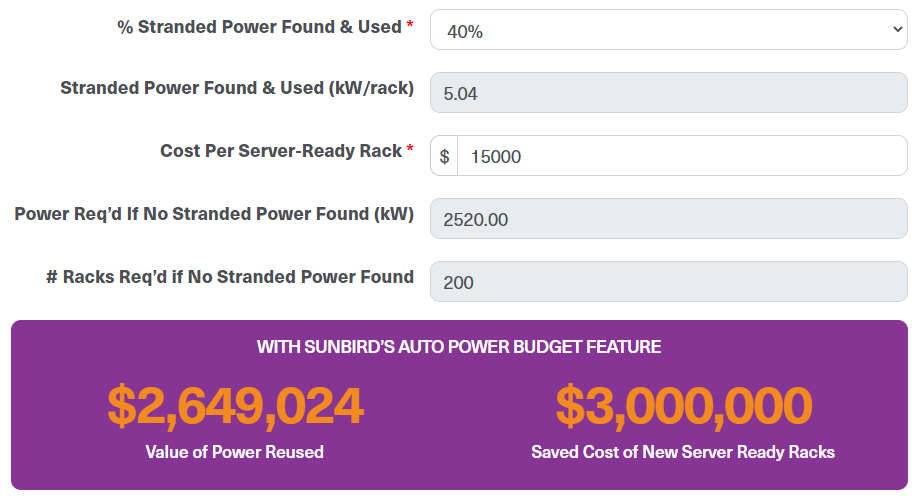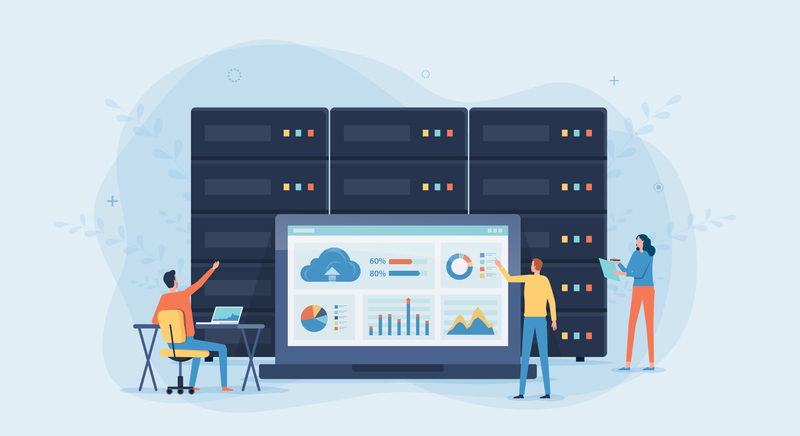What’s Your Data Center Energy Cost? [Free Calculator]
Do you know what your power density per rack is? How about what it costs to power each individual rack for a year? Or all your racks combined?
The fact is that most data center managers don’t know this information, which can be incredibly valuable when it comes to power capacity planning, energy management, and maximizing the utilization of existing resources.
That’s why we created a simple and free tool to make it easy for you to understand your power density and data center energy costs.
Try the “What Does It Cost to Power a Rack?” calculator.
What Does It Cost to Power an Average Data Center?
Let’s try an example, imagining you have an average data center. Your data center pays the US average energy cost of $0.12 per kWh and has 500 racks.
In the calculator, you can select the type of rack PDUs in your cabinet using a dropdown list of popular rack PDU configurations of voltage, amps, and phase. In our example, you have 208V 50A three-phase rack PDUs.
With this information, the calculator can determine that your power density is 12.6 kW per rack and that it costs $13,245 annually to power each rack at 100% usage. In your data center of 500 racks, that amounts to over $6.6 million in total annual data center energy consumption costs.

This information alone is useful. Knowing your power density in kW per rack aids in data center design, capacity planning, and provisioning of cooling and power resources. Knowing your energy usage and costs helps identify potential savings, compare costs across sites, estimate your carbon footprint, and more.
Now, let’s take this example one step further and see how much stranded power and space capacity this hypothetical data center potentially has and how much money you might save by deploying modern DCIM software to find and use that stranded capacity.
First, let’s cover some background information.
What is Stranded Capacity and Why Does It Occur?
Stranded capacity is installed power, space, and cooling resources that are not being used.
Common reasons for stranded capacity include:
- Overprovisioning of data center capacity. Data center managers often build out not just the capacity and redundancy they require, but plenty more with the expectation that the data center should be prepared for any unforeseen circumstances, new applications or services, or incidents that may pose a threat of downtime. Since it costs around $15,000 to deploy a server-ready cabinet, this is a wasteful practice.
- The traditional method of capacity planning isn’t good enough. When budgeting power to determine how many servers can be deployed in a cabinet, it’s common practice for data center managers to derate the nameplate value of a server device to around 60% or 70%. This outdated practice is not only manually intensive but also highly inaccurate due to being based on assumptions and results in stranded capacity.
- Lack of information and proper tools. Data center managers need data to extract actionable insights and make the most informed capacity planning decisions. Those without a modern data center capacity planning solution will not be able to maximize the utilization of their existing resources, leading to stranded capacity.
It is best practice to keep stranded capacity to a minimum since it is a waste of resources. Stranded capacity should be used when deploying new equipment instead of paying to build out expensive additional capacity.
Yet many data center managers struggle with stranded capacity. They don’t know how much they have or where it is which makes finding the best place to provision new equipment difficult.
Fortunately, there is an easy way to identify and use stranded capacity.
How Do I Find and Use Stranded Capacity?
It’s simple. Second-generation DCIM software with an Auto Power Budget feature enables automatic capacity planning that’s highly accurate and lowers risk.
Auto Power Budget automatically calculates an accurate power budget number for each device instance (e.g., make and model of a server) based upon the actual measured load of that device in your environment running your applications.
Customers like Comcast and eBay report getting up to 40% more usage out of their facilities and power resources with Auto Power Budget. Read the Comcast case study for the details.
How Do I Quantify the Value of Finding and Using Stranded Power Capacity?
With the new smart rack calculator, it’s easy to determine your return-on-investment by using a modern DCIM solution to find and use stranded power capacity.
Let’s try it out, using our data center example from earlier.
In the calculator, you can select a percentage of power capacity that is stranded and not being used. We know from customers like Comcast that it’s not uncommon to strand as much as 40% of power resources, so we’ll start there.
The calculator determines that, in this 500-rack data center with a power density of 12.6 kW per rack, if you are stranding 40% of our power, then that is 5.04 kW per rack or 2,520 kW across the entire data center. It also tells us that this amounts to 200 racks’ worth of power.
Next, you can enter what it costs your organization to deploy a server-ready cabinet. Our customers tell us that this number is around $15,000, so we will use this in our example.
With all this information, the calculator shows us our return-on-investment if we were to maximize the utilization of our existing resources with Auto Power Budget rather than building out additional cabinets.
In this example, we now know that the value of the total stranded power is over $2.6 million at 100% usage charge. Further, we can see that if you are stranding 200 racks’ worth of power capacity, then by utilizing those existing resources rather than building out additional cabinets, you will save $3 million in deferred capital expenditures of building more server-ready racks.
Aren’t those savings worth deploying second-generation DCIM software?

Try the New “What Does It Cost to Power a Rack?” Calculator
The above example uses an average-sized data center with commonly used rack PDUs and a typical amount of stranded capacity. Try the calculator yourself using your own data center’s details and find out exactly how much your total and per-rack energy costs are, how much stranded power capacity you potentially have, and what your savings would look like if you were to increase your capacity utilization. You can even email the report to yourself so you always have the data handy.
Want to see how Comcast was able to get 40% more usage out of their facilities and power resources with Sunbird’s world-leading DCIM software? Get your free test drive today!





























